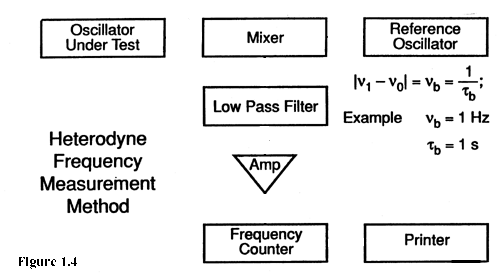Time and Frequency from A to Z: F
Femtosecond (fs) One quadrillionth of a second (10-15 s). Flicker Noise A type of low frequency noise where the power spectral density is inversely proportional to the frequency. For this reason, it is sometimes referred to as 1/f noise. Frequency The rate of a repetitive event. If T is the period of a repetitive event, then the frequency f is its reciprocal, 1/T. Conversely, the period is the reciprocal of the frequency, T = 1/f. Since the period is a time interval expressed in seconds (s), it is easy to see the close relationship between time interval and frequency. The standard unit for frequency is the hertz (Hz), defined as the number of events or cycles per second. The frequency of electrical signals is often measured in multiples of hertz, including kilohertz (kHz), megahertz (MHz), or gigahertz (GHz). Frequency Accuracy The degree of conformity of a measured or calculated frequency to its definition. Since accuracy is related to the offset from an ideal value, frequency accuracy is usually stated in terms of the frequency offset. Frequency Counter An electronic instrument or circuit that displays the frequency of an incoming signal. The frequency is determined by comparing the signal to the counter's time base oscillator. Some frequency counters (often called "universal counters") measure other parameters in addition to frequency, such as time interval and period. Frequency Divider An electronic instrument or circuit that converts an incoming signal to a lower frequency by removing a fixed number of cycles or pulses from the signal. For example, a circuit that divides by 1000 could accept a 1 MHz signal as an input, and produce a 1 kHz signal as an output. Dividers are commonly used to convert the standard output of a frequency standard (often 5 or 10 MHz) to a 1 Hz signal that can be synchronized to UTC for timing applications. Frequency Domain The measurement domain where voltage and power are measured as functions of frequency. A spectrum analyzer is often used to analyze signals in the frequency domain. It does so by separating signals into their frequency components and displaying the power level at each frequency. An ideal sine wave (perfect frequency) appears as a spectral line of zero bandwidth in the frequency domain. Real sine wave outputs are always noisy, so the spectral lines have a finite bandwidth, as shown in the graphic. Noise is usually present over a wide band of frequencies. The total power (or voltage) measured by a spectrum analyzer depends on the bandwidth used.  Frequency Drift An undesired progressive change in frequency with time. Frequency drift can be caused by component aging and environmental changes. Frequency drift may be in either direction (higher or lower frequency) and is not necessarily linear. Frequency Mixer An electronic instrument or circuit that accepts two input signals at two different frequencies, and produces an output frequency (called the beat frequency or difference frequency) equal to the difference of the two inputs. Frequency mixers are commonly employed in frequency measurement systems (as shown in the graphic below), to convert a high frequency to a low frequency, and to obtain more measurement resolution. For example, a 5 MHz signal might be mixed with a 5,000,010 Hz signal. Measuring the 10 Hz beat frequency with a frequency counter (as opposed to the 5 MHz) allows the detection of smaller frequency changes.  Frequency Multiplier An electronic instrument or circuit that converts an incoming signal to a higher frequency by adding a fixed multiple of cycles or pulses to the signal. For example, a circuit that multiplies by 10 could accept a 1 MHz signal as an input, and produce a 10 MHz signal as an output. Frequency Offset The difference between a measured frequency and an ideal frequency with zero uncertainty. This ideal frequency is called the nominal frequency. Frequency offset can be measured in either the frequency domain or the time domain. A simple frequency domain measurement involves directly counting and displaying the output frequency of the device under test with a frequency counter. The frequency offset is calculated as:  where fmeasured is the reading from the frequency counter, and fnominal is the specified output frequency of the device under test. Frequency offset measurements in the time domain involve measuring the time difference between the device under test and the reference. The time interval measurements can be made with an oscilloscope or a time interval counter. If at least two time interval measurements are made, we can estimate frequency offset as follows:  where "delta-t" is the difference between time interval measurements (phase difference), and T is the measurement period. Frequency offset values are usually expressed as dimensionless numbers such as Then, add the frequency offset to the nominal frequency to get the actual frequency: Frequency Shift A sudden change in the frequency of a signal. Frequency Stability The degree to which an oscillating signal produces the same frequency for a specified interval of time. It is important to note the time interval; some devices have good short-term stability, others have good long-term stability. Stability doesn't tell us whether the frequency of a signal is right or wrong, it only indicates whether that frequency stays the same. Frequency Standard An oscillator (usually an atomic oscillator) that is used as a reference source for frequency measurements. The current frequency standard for the United States is a cesium fountain oscillator named NIST-F1. Frequency Synthesizer An electronic device or circuit that can produce a wide range of user selectable output frequencies. In order to produce a wide range of frequencies, frequency synthesizers typically contain several components, including frequency dividers, frequency multipliers, and phase locked loops.
|
